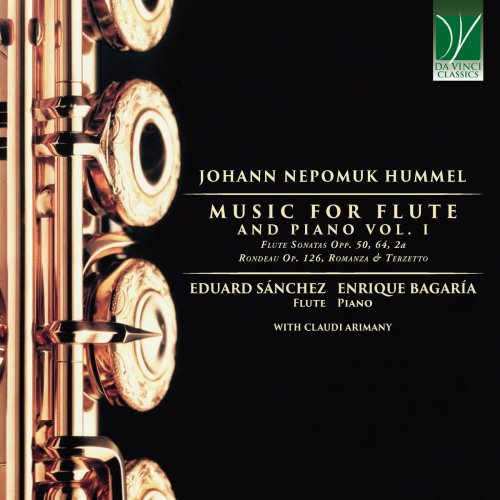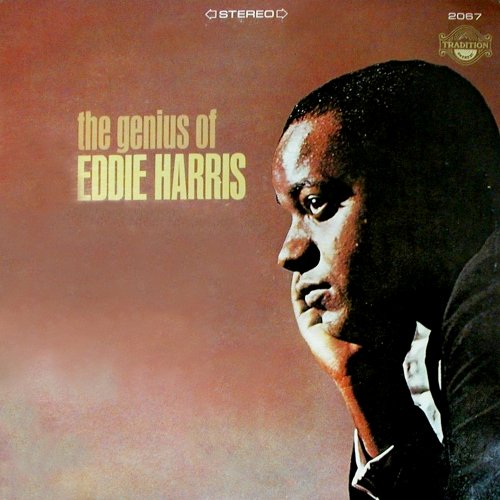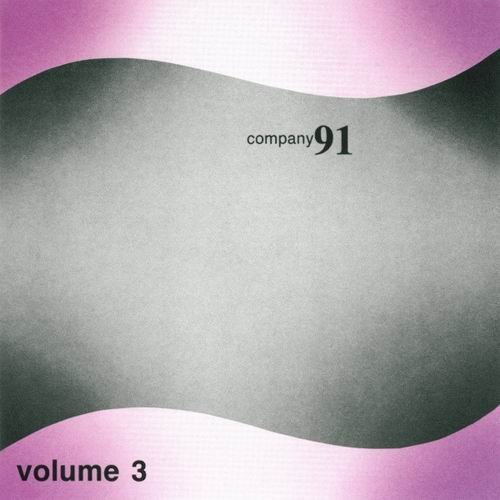Eduard Sánchez - Johann Nepomuk Hummel: Music for Flute and Piano, Vol. 1 (Flute Sonatas Opp. 50, 64 & 2a - Rondeau Op. 126, Romanza & Terzetto) (2024)

Artist: Eduard Sánchez, Enrique Bagaría
Title: Johann Nepomuk Hummel: Music for Flute and Piano, Vol. 1 (Flute Sonatas Opp. 50, 64 & 2a - Rondeau Op. 126, Romanza & Terzetto)
Year Of Release: 2024
Label: Da Vinci Classics
Genre: Classical
Quality: FLAC (tracks)
Total Time: 64:13 min
Total Size: 236 MB
WebSite: Album Preview
Tracklist:Title: Johann Nepomuk Hummel: Music for Flute and Piano, Vol. 1 (Flute Sonatas Opp. 50, 64 & 2a - Rondeau Op. 126, Romanza & Terzetto)
Year Of Release: 2024
Label: Da Vinci Classics
Genre: Classical
Quality: FLAC (tracks)
Total Time: 64:13 min
Total Size: 236 MB
WebSite: Album Preview
01. Flute Sonata in D Major, Op. 50: I. Allegro con brio
02. Flute Sonata in D Major, Op. 50: II. Andante
03. Flute Sonata in D Major, Op. 50: III. Rondo.Pastorale
04. Flute Sonata in A Major, Op. 64: I. Allegro con garbo
05. Flute Sonata in A Major, Op. 64: II. Menuetto moderato
06. Flute Sonata in A Major, Op. 64: III. Rondo. Vivace
07. Flute Sonata in G Major, Op. 2a No.2: I. Allegro
08. Flute Sonata in G Major, Op. 2a No.2: II. Romanze. Poco Andante
09. Flute Sonata in G Major, Op. 2a No.2: III. Rondo. Allegro
10. Grand Rondeau Brillant, Op. 126: Introduzione-Rondo
11. Romanza & Terzetto from the opera Mathilde von Guise for two flutes and piano: Larghetto- Allegro con brio
Johann Nepomuk Hummel (1778-1837) was born in Pressburg (now Bratislava, Slovakia), one of the most beautiful cities in the Habsburg Empire, a “jewel in the crown” of Empress Maria Theresa [1]. The city could boast of numerous theaters, the greathouses of many important noble families, and a vibrant artistic life. Hummel’s father Johannes was a leading violinist in the city and employed to play in the Hauskapelle of Count Antal Grassalkovich II, where he would come in contact with Haydn during his frequent visits there.
Nevertheless, after Johannes discovered that his son was a prodigy on both piano and violin, he decided to move to Vienna to pursue better educational opportunities for him, and perhaps for his own career as well. One of his goals was to ask Mozart if he would teach Johann Nepomuk, and not only did Mozart accept him as his student but insisted that he live with him and Constanza for the two years of instruction. After Hummel completed his studies with Mozart he embarked on a five-year concert debut tour with this father that would take the pair throughout Europe, Scandinavia and the British Isles (where Johann Nepmuk met and collaborated with Haydn, who would later teach him and promote his career). With his reputation as a leading pianist established, Hummel returned to Vienna in 1793 and became Beethoven’s major competitor at the keyboard. The two artists would have a volatile relationship during the next three decades, but they parted at Beethoven’s death bed in 1827 as friends and colleagues.
Hummel’s first position was as Haydn’s successor at the Esterházy court, where he would serve from 1804-1811. He then returned to Vienna to reestablish himself as one of the city’s leading pianists and piano teachers, but with a growing family to support he accepted the position of Kapellmeister at the Stuttgart Court in 1816. He only stayed in Stuttgart for two years of great unhappiness and dissatisfaction (one member of his orchestra wrote that “we have real misery here”), and in 1819 therefore eagerly accepted an invitation to serve as Kapellmeister for the enlightened court of Weimar. Hummel would remain at that court, busy, happy and productive, and with an active touring schedule, until his death in 1837.
During his lifetime, Hummel was considered by most of his contemporaries to be the greatest piano virtuoso of Europe, and one of the most popular composers and teachers of the era. Trained in the classical style of Haydn and Mozart, he became an influence on and a mentor to the next generation of composer-pianists. Schubert, for example, was such an admirer of Hummel that he modelled his “Trout” Quintet on Hummel’s quintet version of his Septet in D minor, op. 74. The young Schumann fervently wanted to study with Hummel, but although this dream was never realized, he remained enthusiastic in his praise of the pianist and his compositions. These included Hummel’s Sonata for Piano in F-sharp minor, op. 81, a work that Schumann claimed would “alone immortalize his name.” Chopin became a lifelong fan when he first heard Hummel perform in Warsaw in 1828, and was reported to claim that “Mozart, Beethoven and Hummel are the masters we all recognize.” It is also not surprising that the opening measures and overall structure of Chopin’s Piano Concerto in E minor, op. 11 are strikingly similar to those of Hummel’s Piano Concerto in A minor, op. 85. Notably, almost every aspiring professional pianist of that era chose either Hummel’s A-minor concerto, op. 85 or his Piano Concerto in B minor, op. 89 as the work with which to make their professional debut. These future virtuosos included Liszt, Clara Schumann, Grieg, Chopin and César Franck, as well as Hummel’s most distinguished students, such as Ferdinand Hiller and Adolf von Henselt. Liszt, moreover, would succeed Hummel as Kapellmeister in Weimar, and although the two artists could not have been more different in terms of the way they played the piano and in their personalities and lifestyles, Liszt maintained a sincere respect and admiration for Hummel and his compositions. He performed Hummel’s concertos, sonatas and especially the Septet in D minor, op. 74, which he arranged for piano four-hands, and also wrote to the Duke of Weimar that he would “be proud to create works that resemble his.”
Nevertheless, after Johannes discovered that his son was a prodigy on both piano and violin, he decided to move to Vienna to pursue better educational opportunities for him, and perhaps for his own career as well. One of his goals was to ask Mozart if he would teach Johann Nepomuk, and not only did Mozart accept him as his student but insisted that he live with him and Constanza for the two years of instruction. After Hummel completed his studies with Mozart he embarked on a five-year concert debut tour with this father that would take the pair throughout Europe, Scandinavia and the British Isles (where Johann Nepmuk met and collaborated with Haydn, who would later teach him and promote his career). With his reputation as a leading pianist established, Hummel returned to Vienna in 1793 and became Beethoven’s major competitor at the keyboard. The two artists would have a volatile relationship during the next three decades, but they parted at Beethoven’s death bed in 1827 as friends and colleagues.
Hummel’s first position was as Haydn’s successor at the Esterházy court, where he would serve from 1804-1811. He then returned to Vienna to reestablish himself as one of the city’s leading pianists and piano teachers, but with a growing family to support he accepted the position of Kapellmeister at the Stuttgart Court in 1816. He only stayed in Stuttgart for two years of great unhappiness and dissatisfaction (one member of his orchestra wrote that “we have real misery here”), and in 1819 therefore eagerly accepted an invitation to serve as Kapellmeister for the enlightened court of Weimar. Hummel would remain at that court, busy, happy and productive, and with an active touring schedule, until his death in 1837.
During his lifetime, Hummel was considered by most of his contemporaries to be the greatest piano virtuoso of Europe, and one of the most popular composers and teachers of the era. Trained in the classical style of Haydn and Mozart, he became an influence on and a mentor to the next generation of composer-pianists. Schubert, for example, was such an admirer of Hummel that he modelled his “Trout” Quintet on Hummel’s quintet version of his Septet in D minor, op. 74. The young Schumann fervently wanted to study with Hummel, but although this dream was never realized, he remained enthusiastic in his praise of the pianist and his compositions. These included Hummel’s Sonata for Piano in F-sharp minor, op. 81, a work that Schumann claimed would “alone immortalize his name.” Chopin became a lifelong fan when he first heard Hummel perform in Warsaw in 1828, and was reported to claim that “Mozart, Beethoven and Hummel are the masters we all recognize.” It is also not surprising that the opening measures and overall structure of Chopin’s Piano Concerto in E minor, op. 11 are strikingly similar to those of Hummel’s Piano Concerto in A minor, op. 85. Notably, almost every aspiring professional pianist of that era chose either Hummel’s A-minor concerto, op. 85 or his Piano Concerto in B minor, op. 89 as the work with which to make their professional debut. These future virtuosos included Liszt, Clara Schumann, Grieg, Chopin and César Franck, as well as Hummel’s most distinguished students, such as Ferdinand Hiller and Adolf von Henselt. Liszt, moreover, would succeed Hummel as Kapellmeister in Weimar, and although the two artists could not have been more different in terms of the way they played the piano and in their personalities and lifestyles, Liszt maintained a sincere respect and admiration for Hummel and his compositions. He performed Hummel’s concertos, sonatas and especially the Septet in D minor, op. 74, which he arranged for piano four-hands, and also wrote to the Duke of Weimar that he would “be proud to create works that resemble his.”
![Eddie "Lockjaw" Davis - Land Of Dreams (1982) [Vinyl] Eddie "Lockjaw" Davis - Land Of Dreams (1982) [Vinyl]](https://www.dibpic.com/uploads/posts/2026-01/1767962313_5.jpg)


![Tulug Tirpan, Eylem Pelit, Volkan Oktem - Pow Trio - On Living (2026) [Hi-Res] Tulug Tirpan, Eylem Pelit, Volkan Oktem - Pow Trio - On Living (2026) [Hi-Res]](https://www.dibpic.com/uploads/posts/2026-01/1767943920_unln0j4m8w6km_600.jpg)




